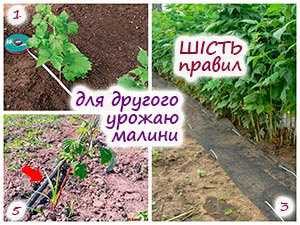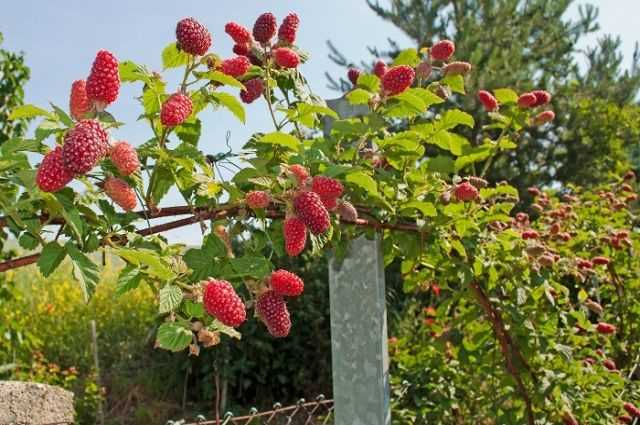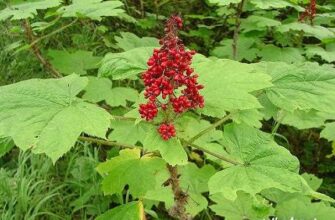- Малиновое дерево: история и происхождение
- Мифы и реальность о малиновом дереве
- Польза и вред малинового дерева
- Как отличить настоящее малиновое дерево
- Характеристики и особенности малинового дерева
- Подделки и распространенные мошенничества
- Способы выращивания малинового дерева
- Выбор места и почвы для посадки малинового дерева
- Правила ухода за малиновым деревом
- Использование малинового дерева
- Применение в медицине и косметологии
- Кулинарные рецепты с использованием малинового дерева
- Вся правда о малиновом дереве
- Как использовать малиновое дерево в кулинарии
- Защита от мошенников при покупке малинового дерева
- Вопрос-ответ:
- Можно ли выращивать малиновое дерево в саду?
- Какие существуют сорта малины и какой лучше выбрать?
- Как правильно ухаживать за малиной?
- Как определить качество саженцев малины?
- Какие мифы связаны с выращиванием малины?
- Видео:
- Штамбовая малина Формировка куста

Малиновое дерево — одно из самых популярных растений среди садоводов. Его яркие ягоды и неприхотливость в выращивании делают его желанным гостем во многих садах. Однако, за всей этой красотой скрывается множество мифов и спекуляций, которые могут обмануть доверчивых садоводов.
Некоторые утверждают, что малиновое дерево способно приносить плоды уже через несколько месяцев после посадки. Они обещают быстрый и обильный урожай, который превзойдет все ожидания. Однако, это лишь миф. Правда в том, что малиновое дерево начинает плодоносить только через несколько лет после посадки, и урожайность зависит от множества факторов, включая условия выращивания и уход за растением.
Вся информация о высокой устойчивости малины к болезням и вредителям также может быть обманчивой. Малина действительно обладает определенной устойчивостью, но она не является полностью неподверженной заболеваниям. Уход за малиновым деревом требует регулярного осмотра и своевременного применения специальных препаратов для предотвращения и лечения болезней.
Остерегайтесь обещаний, которые звучат слишком хорошо, чтобы быть правдой. Малиновое дерево — это прекрасное растение, но оно не является магическим и универсальным средством для всех проблем садоводства. Будьте внимательны и не попадайте на уловки мошенников, которые готовы обмануть вас ради своей выгоды.
Малиновое дерево: история и происхождение
Малиновое дерево, или малиновая груша, является одним из самых интересных и загадочных растений, привлекающих внимание многих садоводов. Несмотря на свое название, оно не имеет ничего общего с малиной и грушей. Как так получилось?
Происхождение названия «малиновое дерево» связано с его внешним видом. Вся его крона, покрытая мелкими яркими цветами, напоминает цветущую малину. Это дерево обладает уникальной способностью обманывать доверчивых садоводов, которые в надежде на урожай малины сажают его в своих садах.
Однако, на самом деле малиновое дерево является родственником грушевых деревьев и происходит из Южной Америки. В дикой природе оно может достигать впечатляющих размеров и своей красотой завораживает всех, кто видит его в живую.
История приобщения малинового дерева к садоводству началась не так давно. Впервые оно было доставлено в Европу в конце XIX века, где было принято за малину. С тех пор малиновое дерево стало популярным растением в садах и парках по всему миру.
Мифы и реальность о малиновом дереве

Малиновое дерево — это одно из самых популярных растений, которое привлекает внимание своими яркими и сочными ягодами. Однако, как и вся популярная тема, вокруг малинового дерева возникло множество мифов и ложной информации.
Как правило, мифы о малиновом дереве связаны с его лечебными свойствами. Некоторые люди уверены, что малиновое дерево обладает чудодейственными способностями и может излечить любое заболевание. Однако, научные исследования показывают, что малина действительно содержит некоторые полезные вещества, но она не является универсальным средством от всех болезней.
Еще одним мифом, который часто обманывает доверчивых людей, является идея о том, что малиновое дерево может выраститься в любом климате. На самом деле, малина является тропическим растением и требует определенных условий для нормального роста и развития. В холодных климатах выращивание малинового дерева может быть проблематичным и требовать дополнительных усилий и затрат.
Таким образом, важно отличать мифы о малиновом дереве от реальности. Малина действительно может быть полезной и вкусной ягодой, но ее лечебные свойства и возможности для выращивания имеют свои ограничения. При выборе малинового дерева для сада или при покупке продуктов на основе малины, важно ориентироваться на научные и проверенные факты, а не на сомнительные обещания и мифы.
Польза и вред малинового дерева

Малиновое дерево, или рубиновое дерево, является популярным растением среди садоводов. Оно обладает множеством полезных свойств и может принести много пользы, однако существуют и некоторые негативные моменты, которые необходимо учитывать.
Польза малинового дерева:
- Малиновое дерево является источником витаминов и антиоксидантов, которые полезны для нашего организма.
- Малиновое дерево используется в кулинарии: его ягоды можно добавлять в десерты, варенье, компоты и другие блюда.
- Малина содержит клетчатку, которая способствует нормализации пищеварения и помогает поддерживать здоровый вес.
- Малиновое дерево является красивым украшением сада и может создать приятную атмосферу благодаря своему яркому цвету и аромату цветов.
Вред малинового дерева:
- Некоторые сорта малины могут иметь колючки, что может вызывать дискомфорт при сборе ягод.
- Малиновое дерево может быть подвержено различным болезням и вредителям, что требует дополнительных усилий для его защиты и ухода.
- Существуют случаи обмана доверчивых садоводов, которые покупают малиновое дерево по завышенной цене или с неправильно указанными характеристиками сорта.
Вся правда о малиновом дереве заключается в том, что оно является ценным растением, которое способно принести пользу и украсить сад, однако необходимо быть осторожными и выбирать сорт, который подойдет для конкретных условий и требований. Также стоит быть внимательными при покупке малинового дерева и обращаться только к проверенным продавцам, чтобы избежать обмана.
Как отличить настоящее малиновое дерево

Малиновое дерево – это редкое растение, которое обладает множеством полезных свойств. Однако, существует большое количество мошенников, которые пытаются обмануть доверчивых садоводов и продать им поддельное дерево.
Как же отличить настоящее малиновое дерево от подделки? В первую очередь, обратите внимание на ствол. Настоящее малиновое дерево имеет прочный и гладкий ствол, который не имеет видимых повреждений или трещин. Если ствол выглядит неестественно или имеет признаки повреждений, скорее всего, это подделка.
Другим способом определить подлинность малинового дерева является проверка листьев. Настоящие листья малинового дерева имеют характерную форму и цвет. Они должны быть мягкими на ощупь и иметь насыщенный зеленый цвет. Если листья выглядят иначе, возможно, это не малиновое дерево.
Также стоит обратить внимание на плоды малинового дерева. Настоящие плоды должны быть крупными, сочными и иметь характерный малиновый цвет. Если плоды выглядят неестественно или имеют отличный от малинового цвет, скорее всего, это подделка.
Важно помнить, что правда всегда находится в деталях. При покупке малинового дерева не стоит спешить и тщательно изучите все его характеристики. Таким образом, вы сможете отличить подделку от настоящего малинового дерева и избежать обмана.
Характеристики и особенности малинового дерева
Малиновое дерево – одно из самых популярных плодовых культур, которое пользуется большой популярностью среди садоводов. Оно является довольно неприхотливым растением и может произрастать в различных климатических условиях.
Как правило, малиновое дерево обладает высокой урожайностью, благодаря чему оно пользуется большой популярностью среди садоводов. Плоды малины богаты витаминами и микроэлементами, что делает их полезными для здоровья человека.
Однако, доверчивых садоводов иногда обманывают, предлагая им некачественные саженцы малинового дерева. Поэтому, перед покупкой необходимо обратить внимание на следующие особенности: качество саженцев, возраст растения, его состояние и сроки плодоношения.
Важно отметить, что малиновое дерево требует достаточно внимания и заботы, особенно в период цветения и плодоношения. Необходимо регулярно проводить обрезку и подкормку растения, а также обеспечивать его защиту от вредителей и заболеваний.
Подделки и распространенные мошенничества

Малиновое дерево является очень популярным среди садоводов и любителей садоводства. Однако, как это часто бывает, популярность этого растения привлекает мошенников, которые готовы обмануть доверчивых покупателей.
Как правило, мошенники предлагают подделки малинового дерева, которые выглядят похоже на оригинал, но на самом деле не имеют тех же качеств и свойств. Они могут использовать различные приемы, чтобы обмануть покупателя: менять сорта малинового дерева, предлагать некачественные саженцы или даже продавать обычное кустарниковое растение под видом малинового дерева.
Вся проблема заключается в том, как отличить подделку от настоящего малинового дерева. Для этого нужно быть внимательным и знать некоторые признаки настоящего растения. Настоящее малиновое дерево имеет специфическую форму куста, листья и плоды. Оно также обладает определенными свойствами и качествами, которые мошенники не могут подделать.
Поэтому, перед тем как приобрести малиновое дерево, необходимо быть осведомленным о его особенностях и хорошо изучить его характеристики. Также рекомендуется обращаться только к проверенным поставщикам, чтобы избежать попадания на уловки мошенников.
Способы выращивания малинового дерева
Малиновое дерево — одно из самых популярных плодовых растений среди садоводов. Оно отличается своей красотой и вкусом, но чтобы успешно вырастить малиновое дерево, нужно знать несколько способов.
Во-первых, выбор места для посадки малинового дерева играет важную роль. Это дерево предпочитает солнечные места с плодородной почвой. Подготовьте почву, добавив органические удобрения и проверьте ее кислотность. Малиновое дерево любит нейтральную или слабокислую почву.
Как правило, малиновое дерево размножается черенками или семенами. Если вы выбрали размножение черенками, то необходимо правильно подготовить черенки и посадить их во влажную почву. Следите за влажностью почвы в первые недели после посадки.
Так стоп!!! Вы всё ещё не подписаны на наши каналы в Телеграмм и Дзен? Посмотрите: ТГ - (@historyfantasydetectivechat) и Дзен (https://dzen.ru/myshortsstorys)
Если вы предпочитаете размножение малинового дерева семенами, то следует помнить, что этот процесс может занять много времени и потребовать терпения. Семена высевают в грунт весной или осенью и ждут прорастания.
Однако, несмотря на все рекомендации, мошенники могут обманывать доверчивых садоводов, предлагая неадекватно высокую цену на малиновое дерево, или продавая неправильно подготовленные черенки. Поэтому, будьте бдительны и обращайтесь только к проверенным поставщикам и продавцам.
Выбор места и почвы для посадки малинового дерева

Малиновое дерево — это растение, которое требует особого внимания при выборе места и почвы для его посадки. Вся суть успеха зависит от правильного выбора условий, в которых будет расти растение.
Как правило, малиновое дерево предпочитает солнечные места. Оно нуждается в достаточном количестве света для нормального развития и плодоношения. Поэтому рекомендуется выбирать открытое место, где оно будет получать максимальное количество солнечных лучей.
Однако, следует помнить, что малиновое дерево необходимо защищать от перегревания. Поэтому рекомендуется выбирать место с небольшой тенью, особенно в жаркое время года. Это поможет избежать пересыхания почвы и негативного влияния высоких температур на корневую систему растения.
Что касается почвы, малиновое дерево предпочитает рыхлые, плодородные и хорошо дренированные почвы. Оно не выносит избыточной влаги и заболевает, если почва постоянно мокрая. Поэтому рекомендуется выбирать почву, которая способна быстро отводить излишки влаги и сохранять ее в нужных количествах для растения.
Важно помнить, что малиновое дерево обладает повышенной устойчивостью к различным заболеваниям и вредителям. Это помогает садоводам успешно выращивать это дерево и получать хороший урожай. Однако, не стоит забывать о возможности мошенников, которые обманывают покупателей некачественным саженцами малинового дерева. Поэтому при покупке следует обратить внимание на репутацию продавца и проверить качество саженцев.
Правила ухода за малиновым деревом

Уход за малиновым деревом требует внимания и знаний, чтобы не попасть на уловки мошенников, которые обманывают доверчивых садоводов. Как правило, малиновое дерево нуждается в следующих условиях для успешного развития:
- Полив: Малиновое дерево требует регулярного полива, особенно во время засушливых периодов. Однако, следует избегать чрезмерного полива, чтобы не вызвать гниение корней.
- Удобрение: Вся питательность почвы должна быть обеспечена для обеспечения хорошего роста и развития малинового дерева. Рекомендуется применять органические и минеральные удобрения с учетом потребностей растения.
- Обрезка: Регулярная обрезка малинового дерева помогает формированию красивой кроны и стимулирует цветение. Удаляйте больные, поврежденные и старые ветви, обрезайте длинные побеги для поддержания компактной формы.
- Защита от вредителей: Малиновое дерево может быть атаковано различными вредителями, такими как малиновый жук, малиновая муха и малиновый клещ. Регулярный осмотр и применение соответствующих мер защиты помогут избежать ущерба.
- Зимовка: Малиновое дерево является морозоустойчивым, однако, в холодные зимы, особенно при отсутствии снежного покрова, рекомендуется укрыть основной ствол мешком или специальными материалами для защиты от низких температур.
Следуя этим простым правилам, вы сможете обеспечить здоровый рост и развитие вашего малинового дерева. Помните, что внимание и забота являются ключевыми факторами успеха в садоводстве!
Использование малинового дерева
Малиновое дерево является популярным растением среди садоводов, благодаря своей красивой листве и вкусным плодам. Однако, как и вся популярная информация, вокруг малинового дерева появляются мифы, которые обманывают доверчивых садоводов.
Во-первых, многие считают, что малиновое дерево можно выращивать только в теплых климатических условиях. На самом деле, малиновое дерево достаточно устойчиво к холоду и может успешно расти даже в северных регионах. Главное — выбрать правильный сорт и обеспечить растению хорошие условия.
Во-вторых, существует мнение, что малиновое дерево является самоопыляющимся и не нуждается в наличии других растений для опыления. На самом деле, как и многие другие фруктовые деревья, малиновое дерево нуждается в наличии пыльцы других растений для успешного опыления и формирования плодов.
Также, многие считают, что малиновое дерево не требует особого ухода и можно просто оставить его без внимания. Однако, для получения хорошего урожая и здорового растения, необходимо правильно ухаживать за малиновым деревом. Это включает в себя регулярное поливание, подкормку, обрезку и защиту от вредителей и болезней.
Применение в медицине и косметологии
Малиновое дерево имеет множество полезных свойств, которые находят применение в медицине и косметологии. Его листья, ягоды и кора содержат целебные вещества, которые способны справиться с различными проблемами организма.
В медицине малиновое дерево используется как антиоксидант, имеющий противовоспалительное действие. Оно помогает укрепить иммунную систему, борется с инфекциями, снимает отеки и улучшает кровообращение. Также малиновое дерево способно снижать уровень сахара в крови и поддерживать здоровый уровень холестерина.
В косметологии малиновое дерево используется в различных средствах для ухода за кожей. Оно способно увлажнять и питать кожу, оказывая успокаивающее и омолаживающее действие. Малиновое дерево также помогает сократить воспаление, устранить покраснения и улучшить цвет лица.
Для доверчивых садоводов важно знать, что малиновое дерево действительно имеет множество полезных свойств, которые могут быть использованы в медицине и косметологии. Однако, как и в любой области, важно быть осведомленным и обращаться только к надежным и проверенным источникам информации. Не стоит доверять мифическим и недостоверным обещаниям о «магических» свойствах малинового дерева, а следует обращаться к профессионалам, которые могут предложить научно обоснованные решения и рекомендации.
Кулинарные рецепты с использованием малинового дерева

Малиновое дерево является одним из любимых плодовых деревьев садоводов. Его вкусные и ароматные ягоды используются в кулинарии для приготовления различных блюд и напитков. Как правило, малиновое дерево не обманывает своих почитателей и радует их щедрым урожаем.
Вся правда о малиновом дереве

Многие садоводы и любители природы пытаются вырастить малиновое дерево на своем участке. Но не все знают, что на самом деле малиновое дерево не является настоящим деревом, а скорее кустарником. Его стебли имеют прочную конструкцию, позволяющую держаться на ногах даже при обильном урожае.
Как правило, малиновое дерево обманывает садоводов своим внешним видом. Оно выглядит очень декоративно и привлекает внимание своими красивыми и изящными листьями. Однако, главная ценность этого растения – его ягоды, которые обладают неповторимым вкусом и ароматом.
Как использовать малиновое дерево в кулинарии

Малиновое дерево предлагает множество возможностей для приготовления вкусных и полезных блюд. Ягоды малины можно добавлять в салаты, выпечку, десерты и мороженое. Они отлично сочетаются с кислыми и сладкими ингредиентами, придавая блюдам особый вкус и аромат.
Одним из популярных рецептов с использованием малинового дерева является приготовление варенья. Для этого необходимо собрать спелые ягоды, промыть их, смешать с сахаром и варить на слабом огне, пока не получится густая и ароматная масса. Полученное варенье можно использовать для наполнения пирогов, тарталеток или просто намазывать на хлеб. Это отличный способ сохранить летний вкус малины на зиму.
В заключение, малиновое дерево является не только красивым растением, но и полезным ингредиентом для кулинарии. Его вкусные ягоды могут украсить любое блюдо и подарить незабываемый вкусовой опыт. Разнообразьте свою кулинарную практику, экспериментируйте с малиновым деревом и получайте удовольствие от его ягод!
Защита от мошенников при покупке малинового дерева
Приобретение малинового дерева может стать настоящим испытанием для доверчивых садоводов. В мире существует множество обманщиков, которые готовы использовать любые средства, чтобы получить вашу доверительность и деньги. Как не попасть в их ловушку и приобрести качественное малиновое дерево?
Первое и самое важное правило — не верьте всему, что говорят продавцы малиновых деревьев. Многие из них могут внушать вам неправду, чтобы продать свою товар на выгодных условиях. Перед покупкой обязательно проконсультируйтесь с опытными садоводами или специалистами в области малиноводства.
Очень важно осмотреть малиновое дерево перед покупкой. Обратите внимание на состояние корневой системы, листьев и ствола. Здоровое дерево должно иметь прочные корни, зеленые и не поврежденные листья, а ствол должен быть прямым и без трещин.
Не забывайте также проверить репутацию продавца. Узнайте, сколько лет он занимается продажей малиновых деревьев, есть ли у него положительные отзывы от других садоводов. Лучше всего обратиться к проверенным поставщикам, которые давно на рынке и зарекомендовали себя надежными поставщиками качественных малиновых деревьев.
Не забывайте, что малиновое дерево — это живой организм, и оно требует заботы и внимания. Поэтому перед покупкой узнайте, как правильно ухаживать за малиновым деревом. Это поможет вам сохранить его здоровье и красоту на долгие годы.
Вопрос-ответ:
Можно ли выращивать малиновое дерево в саду?
Нет, малиновое дерево не существует. Малина растет на кустарниках.
Какие существуют сорта малины и какой лучше выбрать?
Существует большое количество сортов малины, каждый из которых имеет свои особенности. Лучший выбор зависит от ваших предпочтений, климатических условий и возможностей по уходу за растением.
Как правильно ухаживать за малиной?
Для успешного выращивания малины необходимо обеспечить ей достаточно света, влаги и питательных веществ. Регулярное поливание, подкормка и удаление сорняков помогут малине расти и плодоносить. Также необходимо обрезать старые побеги и обеспечить опору для куста.
Как определить качество саженцев малины?
Качественные саженцы малины имеют здоровые корни, без повреждений и засохших частей. Также они должны иметь развитые почки и быть свободными от видимых болезней и вредителей.
Какие мифы связаны с выращиванием малины?
Одним из распространенных мифов является то, что малина растет на деревьях. Также часто говорят, что малина невозможна для выращивания в определенных климатических условиях. Однако, существуют сорта малины, которые приспособлены к различным климатам.








